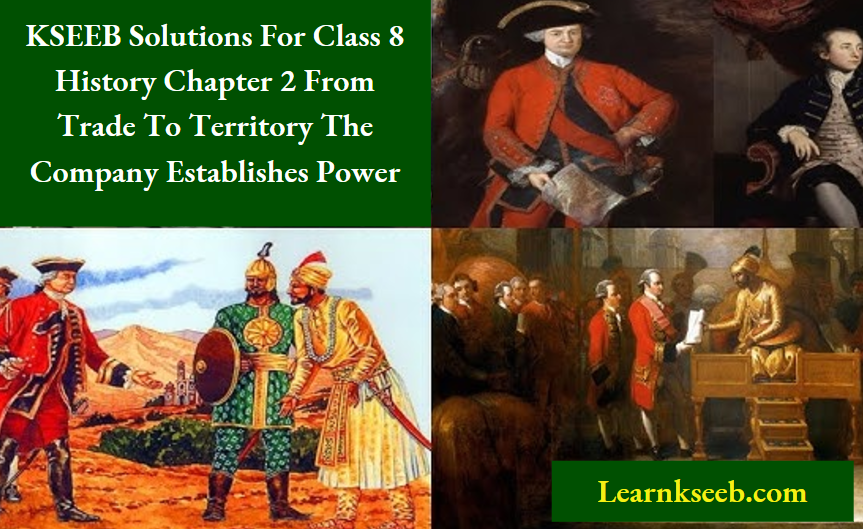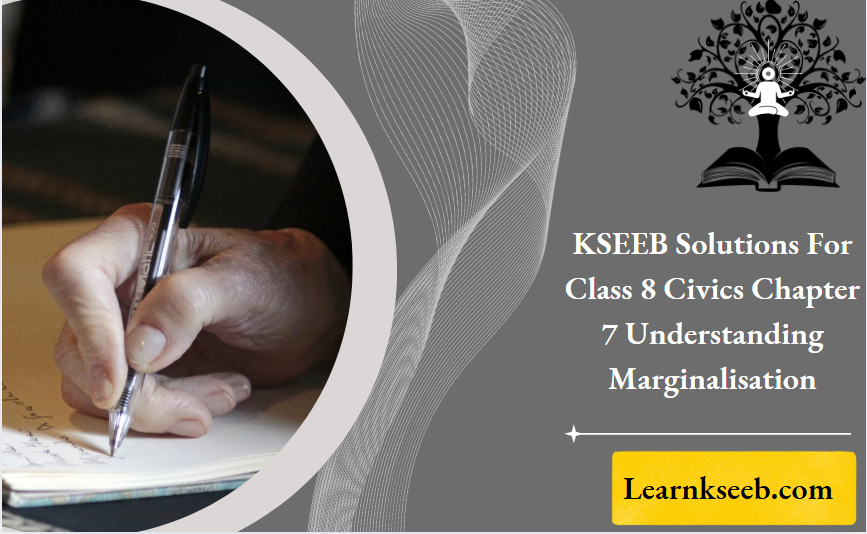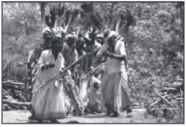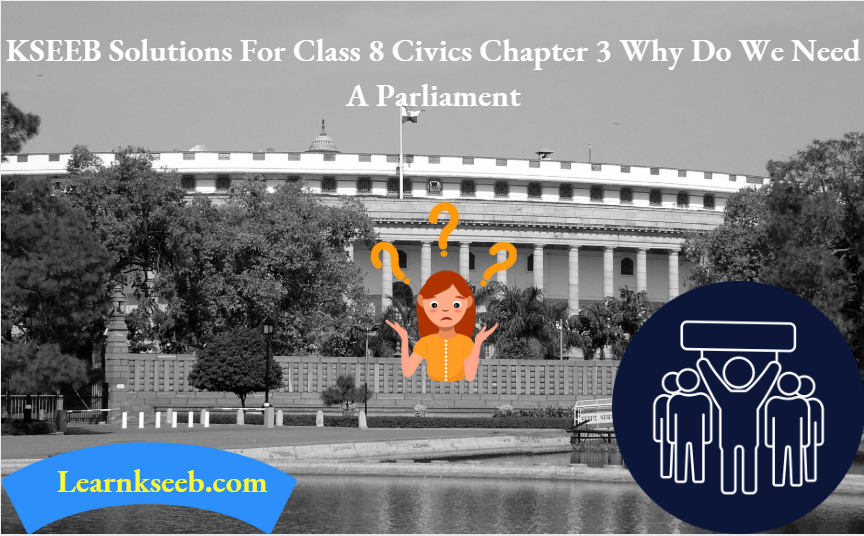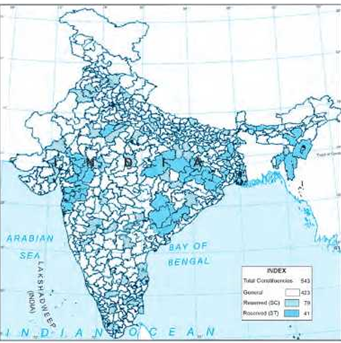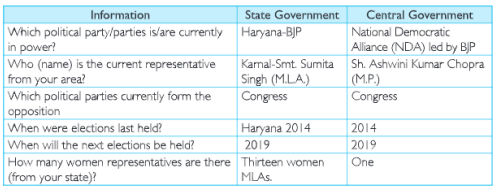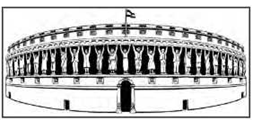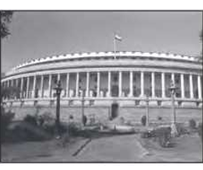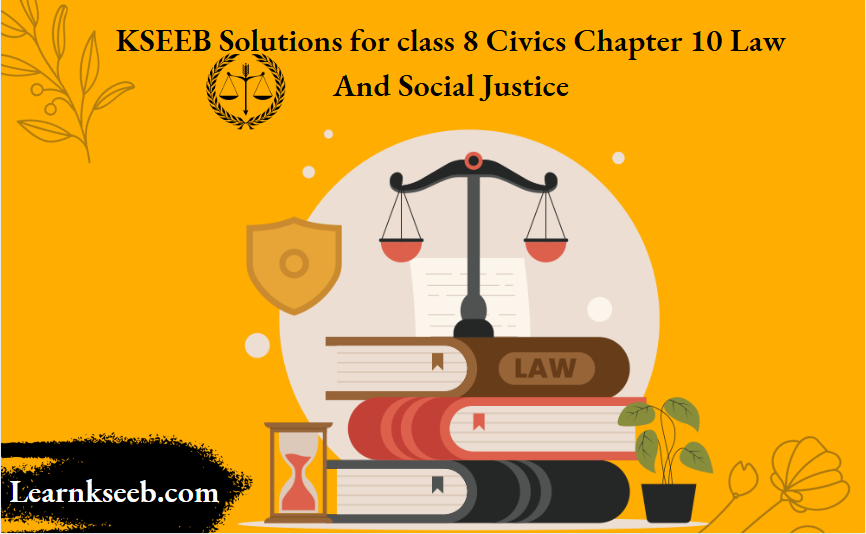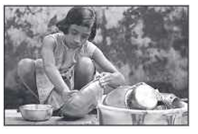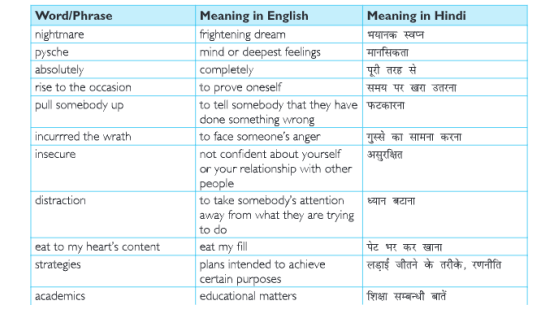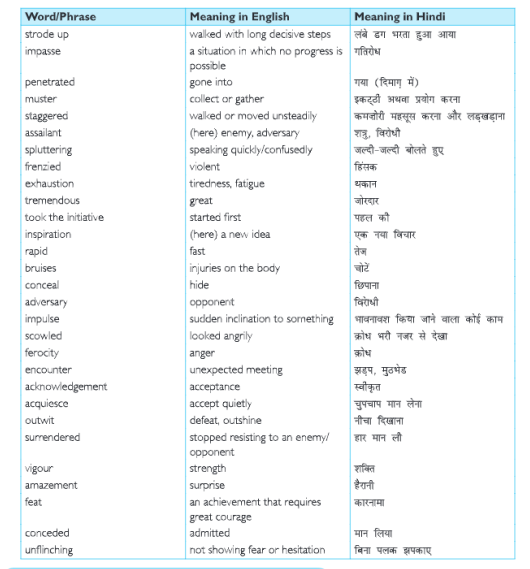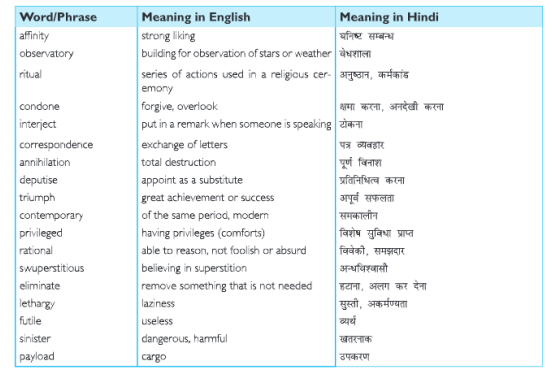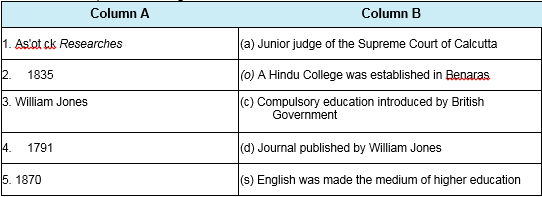KSEEB Solutions Class 8 History Chapter 11 The Making Of The National Movement: 1870s-1947 Textbook Questions
Question 1 Why were people dissatisfied with the British rule in the 1870s and 1880s?
Answer.
- The colonial government passed certain laws like Arms Act and Vernacular Press Act. The Arms Act disallowed the Indians to keep any arms. The Press Act was passed to refrain people from criticising the government policies.
- The llbert Bill laid down that Europeans could be tried by the Indian judges. The British in India opposed it and the Bill was not passed. The Indians realised that the British did not treat Indians equally.
In general, the Indians thought that the Britsh were unfair and there was extreme discontentment with the colonial government.
Question 2 Who did the Indian National Congress wish to speak for?
Answer.
The Indian National Congress wished to speak for the Indians. It demanded greater representation for the Indians in the colonial government. More Indians should become part of the Legislative Councils. Also, it proposed that Indians should be allowed to hold higher administrative posts. It demanded that the Civil Services Examination should be conducted in India as well.
Question 3 What economic impact did the First World War have on India?
Answer.
- The War increased the expenditure of the government which led to imposition of higher taxes on the people.
- The War created a demand for war supplies. As a result, there was a sharp increase in the prices of the commodities in the markets.
- The War created an urgent need for certain goods. This resulted in expansion of some local industries because the demand for goods was high.
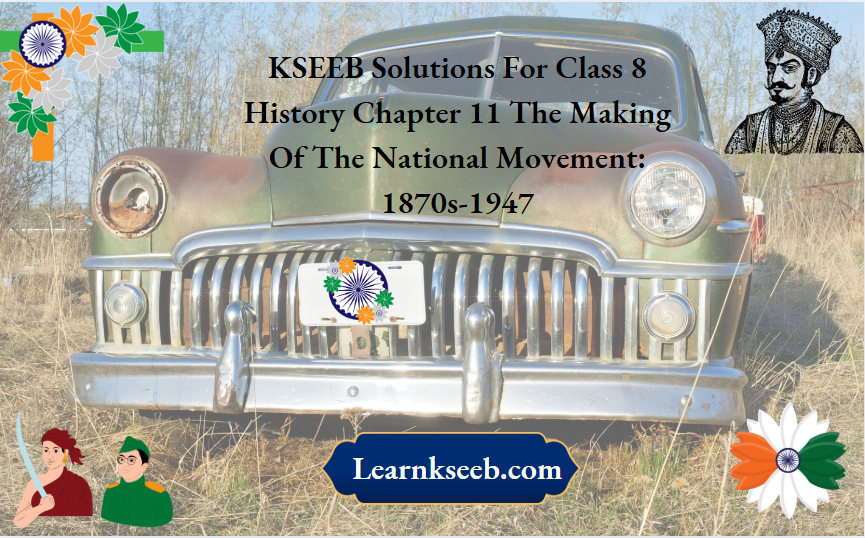
Question 4 What did the Muslim League resolution of I940 ask for?
Answer. The Muslim League passed a resolution in 1940 demanding “independent states” in the eastern and north-western provinces. However, it did not mention the division of the country or the formation of the new state of Pakistan.
Question 5 Who were the Moderates? How did they propose to struggle against British rule?
Answer. The Moderates were early Congress leaders who believed that British were just They wanted to maintain friendly relations with the British. Their demands were limited such as increased party passion in administration and social reform. They would write proposals and send memorandums to British officials. They spread awareness among the people about the loss of wealth from India and the poor conditions of the masses.
Question 6 How was the politics of the Radicals within the Congress different from that of the Moderates?
Answer. Following were the differences between the politics of Aggressive Nationalists and Moderates:
- The Moderates wanted limited self-government within British rule and the Aggressive
Nationalists demanded complete independence. - The Moderates wanted to send petitions and appeals to the government besides passing
resolutions. On the other hand, the Aggressive Nationalists wanted to launch mass protests. !demonstrations and strikes. - The Moderates believed in the British sense of justice and fair play. The Aggressive Nationalists
thought that the British were not concerned about the welfare of the people.
Question 7 Discuss the various forms that the Non-Cooperation Movement took in different parts of India. How did the people understand Gandhiji?
Answer. The Non-Cooperation Movement was launched on a huge scale. Numerous Indians refused to work for the government and boycotted foreign goods. The Patidar peasants of Kheda in Gujarat launched
protests against the high revenue demands. Several liquor shops were picketed in parts of Andhra and Tamil Nadu. Many peasants and tribals broke rules in protest. They organised forest satyagraha in many villages. Many people looked up to Gandhiji to lead their struggle against the British.
Question 8 Why did Gandhiji choose to break the salt law?
Answer. In 1930, Gandhiji decided to break salt laws and organised a long march from Sabarmati to Dandi. A number of people joined him in his protest According to the salt laws, only the government could manufacture and sell salt, and the taxes on salt were very high. The nationalist Indians felt that salt was an essential food item and should not be taxed. Gandhiji and his followers protested by making their own salt.
Class 8 History The Making Of The National Movement KSEEB Notes
Question 9 Discuss those developments of the 1937-47 period that led to the creation of Pakistan.
Answer. In the 1930s, the Muslim League began to drift away from the Congress. It took advantage of the communal tension and widened its social base. The Congress refused to accept that it did not represent the interest of Indian Muslims. In the provincial elections of 1937, the League wanted to form a joint government in the United Provinces. The Congress did not accept this demand.
In 1940, Muhammad All Jinnah passed a resolution demanding ‘independent states in the Muslim-majority provinces. When most of the Congress leaders were in jail during the Quit India Movement, the League carried out its propaganda. In the provincial elections of 1946, the Muslim League performed very well in the reserved constituencies for the minorities.
When the Cabinet Mission was sent to India, both the League and Congress rejected its recommendations. The Muslim League continued to demand a separate state for the Muslims. The League declared 16th August 1946 as the Direct Action Day to strengthen its demand for Pakistan. Riots broke out in several parts of the county Lord Mountbatten, the last Viceroy of India, finally decided that India would be divided. The new state of Pakistan was thus formed on 14th August 1947.
The Making of the National Movement: 1870s-1947 Text Questions
Question 1 From the beginning the Congress sought to speak for, and in the name of, all the Indian people. Why did it choose to do so?
Answer. The Indian National Congress stood for the principle of unity in India since its formation. It sought support from all the classes, groups, and communities in India. The Congress could enlist the support of many people through such a vision and the freedom struggle remained strong and widespread.
Question 2 What problems regarding the early Congress does this comment highlight?
Answer. The early leaders of the Congress were rich and well-to-do Indians unaware of the problems of the masses. They resorted to ’soft’ means of appeals and resolutions. They believed that the British would mostly agree with their demands. When the British did not concede, it showed the failure of the policies of the Moderates.
The Making of the National Movement: 1870s-1947
Question 3 Find out which countries fought the First World War.
Answer. The First World War was fought between the Allied and the Central Powers. Britain, France, and Russia were the chief Allies, who fought against Germany, Austria-Hungary, and Turkey. The Central Powers lost the War and the Allies were victorious.
Question 4 Find out about the Jallianwala Bagh massacre. What is Jallianwala Bagh? What atrocities were committed there? How were they committed?
Answer. On 10th April 1919, two Congress leaders, Dr. Saifuddin Kitchlevv and Dr. Satya Pal were arrested in Punjab. On 13th April 1919, a peaceful meeting was held at Jallianwala Bagh (a public park) in Amritsar to protest against the arrest of those leaders. While the meeting was going on peacefully, General Dyer entered the park with his troops. He blocked the exit ends of the park and ordered the troops to fire openly. The firing continued for I0 minutes. Hundreds of people were killed or wounded. The massacre aroused public anger and numerous people came out in revolt. As a result, Michael O’ Dwyer, the Lieutenant Governor of Punjab, imposed martial law in the province.
Question 5 How did people view Mahatma Gandhi? Why do you think they felt that lie was opposed to zamindars but not to the government? Why do you think they were in favor of Gandhiji?
Answer. Mahatma Gandhi was viewed by the general public as a noble and an extraordinary person. He was held equal in power to a god or a deity. His ideas and decisions were held supreme. He must have opposed the zamindars because of their unjust treatment of the farmers. He led the struggle to stop the illegal eviction of peasants. The common people, therefore, supported and respected him a lot.
The Making of the National Movement: 1870s-1947 Additional Questions (Solved)
Very Short Answer Type Questions
Question 1 What was the Arms Act of 1878?
Answer. The Arms Act of 1878 disallowed Indians from possessing and using any type of arms.
Question 2 What was the Vernacular Press Act?
Answer. The Vernacular Press Act was passed to control free speech and the media. The government could seize the property of any press or newspaper office if it was found to publish anything ‘objectionable’.
Question 3 Who introduced the Albert Bill and why?
Answer. The Albert Bill was introduced by Lord Ripon to put the Indian judges on par with the British judges.
Question 4 Who founded the Indian National Congress and when?
Answer. A retired British official, A.O. Hume, played an instrumental role in establishing the Indian National Congress. It was founded in 1885.
Question 5 Who was the President of the first session of the Congress?
Answer. Womesh Chandra Banerjee was the first President of the Indian National Congress. 72 delegates took part in the session.
Question 6 Name some Moderate leaders.
Answer. Dadabhai Naoroji, Ferozeshah Mehta, Surendra Nath Banerjee, Gopal Krishna Gokhle, and Moan Mohan MaJviya were some of the Moderates.
Question 7 What was the slogan given by Bal Gangadhar Tilak?
Answer. Bal Gangadhar Tilak gave the slogan, “Freedom is my birthright and I shall have it
KSEEB Class 8 History Chapter 11 Questions And Answers
Question 8 Name a few nationalist leaders of the Congress.
Answer. Bal Gangadhar Tilak, Bipin Chandra Pal, and Lala Lajpat Rai were some national st leaders of the Congress.
Question 9 When and why did the Partition of Bengal take place?
Answer. Lord Curzon decided to divide Bengal in $05. He declared that the division was necessary for proper administration, but he actually wanted to prevent Indians from uniting against the British.
Question 10 When was the All-India Muslim League founded?
Answer. The All-India Muslim League was founded in 1906.
Question 11 When did the Congress split took place and when was it reunited?
Answer. The Congress split at Surat in 1907. It was reunited in December 1916.
Question 12 When and why was Lucknow Pact signed?
Answer. The Lucknow Pact was signed in 1916 between the Congress and the Muslim League.
Question 13 How did the British Government reduce its financial loss during the First World War?
Answer. The Brtish Government increased taxes on individual incomes and trade profits to reduce its financial losses in the War.
Question 14 When did the Russian Revolution take place and how did it inspire the Indians?
Answer. The Russian Revolution took place in 1917. It inspired the Indians when they got to know about the peasants’ movements and workers’ strikes.
Question 15 Why did Mahatma Gandhi go to Ahmedabad in 1918?
Answer. Mahatma Gandhi went to Ahmedabad in 1918 to support the satyagraha protest of the cotton-mill workers.
Question 16 What did Mahatma Gandhi decide in 1919?
Answer. Mahatma Gandhi decided to launch a nationwide satyagraha against the proposed Rowlatt Act in 1919.
Question l7 What was the Rowlatt Act?
Answer. The Rowlatt Act was passed in 1919 which gave the power to the British to arrest anyone without providing a fair trial.
Question 18 When did Jallianwala Bagh massacre take place? Who was responsible for it?
Answer. The Jallianwala Bagh massacre took place on 13th April 1919 in Amritsar. General Dyer ordered his soldiers to open fire at the people.
Question 19 Why was the Non-Cooperation Movement withdrawn?
Answer. In February 1922, some people set fire to a police station at Chauri Chaura in U.P. It led to the killing of many people, and therefore, the Non-Cooperation Movement was withdrawn.
Question 20 When did the Indian National Congress demand Purna Swaraj?
Answer. The Indian National Congress demanded complete independence in 1929 at its Lahore Session.
Question 21 What was the Dandi March?
Answer. Mahatma Gandhi and his followers marched for about 240 miles from Sabarmati to the coastal town of Dandi to defy salt laws. It is known as the Dandi March.
Question 22 When did Quit India Movement begin?
Answer. The Quit India Movement began in 1942 in the middle of the Second World War.
Question 23 What was the Cabinet Mission Plan?
Answer. In March 1946, the British Cabinet appointed a three-member committee to decide the future of free India. It proposed that India should remain united with limited autonomy n the Muslim-majority areas.
Question 24 Why did the Muslim League observe Direct Action Day?
Answer. After the failure of the Cabinet Mission, the Muslim League launched an agitation for demanding a separate state of Pakistan. Hence, it decided to observe 16th August 1946 as Direct Action Day.
The Making of the National Movement: 1870s-1947 Short Answer Type Questions
Question 1 Write a note on the Swadeshi and Boycott Movement.
Answer. The Swadeshi and Boycott Movement started in 1905 in Bengal after the province was divided, Soon, it spread to other parts of the country. Important leaders of this movement were Surendra Nath Banerjee, Bipin Chandra Pal, and Bal Gangadhar Tilak. Public meetings were held at many places. People took other to use locally-made goods and to boycott foreign-made goods. Shop- j keepers were asked not to sell foreign goods, -foreign cloth was burnt in many parts of the country, Nat realise newspapers also propagated to boycott foreign goods. The Swadeshi Movement led to the rise of nationalist sentiment among the masses of the country.
The Making Of The National Movement KSEEB Class 8 Textbook Solutions
Question 2 Write the main objectives and ideas of the nationalist leaders in the Congress.
Answer. The following were the main objectives of the Aggressive Nationalists:
- Attainment of complete independence: The primary objective of the nationalist leaders was to attain complete freedom. This demand was put forward by Bal Gangadhar Tilak He said, “Swaraj is my birthright, and I shall have it” He believed that polity and administration should be based on Indian traditions and culture.
- End of Indian Relations with England: The other objective of the nationalist leaders was to end relations between India and England. Bipin Chandra Pal said, “We don’t want to keep any relations with the British. We want to have our own government in India.”
Question 3 Write the main objectives of the Muslim League.
Answer. The following were the main objectives of the Muslim League:
- To protect the interests of Indian Muslims,
- To remain loyal towards the British Government so that British could favor them,
- To divert Indian Muslims from supporting Indian National Congress,
- To establish separate electorates for Muslims, and
- To demand a separate state of Pakistan for Muslims.
Question 4 Describe the Lucknow Pact.
Answer. The First World War started in Europe in I9I4 c.E. The British fought against the Islamic state of Turkey in this war. The Sultan of Turkey was the religious leader or Caliph of all the Muslims in the world. The Muslims all over the world were unhappy at the ill-treatment of the Caliph by the Western powers. The Muslim League, therefore, decided to join hands with the Congress. In return, the Congress agreed to the League’s demand for separate electorates. This was concluded in the Lucknow Pact in 1916. The national movement acquired immense strength as both the communities united against the British.
Question 5 What was the impact of the English language on the spirit of nationalism?
Answer. The Indians studied English as it had become the official language of administration. Now Indians from different states were able to talk to one another through the medium of English. The English language thus helped in bringing different people together. Also, Western education taught Indians about the ideas of equality, democracy, and self-rule. They began to unite against the British for attaining freedom.
Question 6 Write a note on the Civil Disobedience Movement.
Answer. Mahatma Gandhi started the Civil Disobedience Movement in 1930 to attain freedom from the British. He broke the salt laws at a place called Dandi in Gujarat Encouraged by this incident, people of all coastal areas started violating the salt laws. A pact was signed between Mahatma Gandhi and Lord Irwin in 1931. All those who had violated the law were freed. Mahatma Gandhi went to England to participate in the Second Round Table Conference, but they did not agree upon anything. After his return from England. Mahatma Gandhi re-launched the agitation. He was arrested by the British. The Congress was declared illegal by the Government and hundreds of leaders were sent to jail. The police committed several atrocities on the people to suppress the movement.
Question 7 Write a note on the Quit India Movement.
Answer. The Congress passed the Quit India Resolution on 8th August 1942 in Mumbai. The next day, all the prominent members of the Congress were arrested. People reacted through several strikes and demonstrations. They attacked the public buildings and offices. Gandhiji gave the famous slogan, “Do or die”, which inspired the entire nation. The British Government resorted to severe means for crushing the movement. Hundreds were jailed, tortured, or killed, but the movement kept growing.
Question 8 Describe the life of Mahatma Gandhi before 1915.
Answer. Mahatma Gandhi was born on 2nd October. 1869 at Porbandar in Gujarat. His mother was Putli Bai. Mahatma Gandhi received his early education in India and went to England for higher education. He became a barrister and came back to India in 1891. He then went to South Africa in 1893. He saw there that the Indians were mistreated b/ the ‘whites’. He launched a non-violent campaign in support of giving equal rights to the Indians. Many Indians living there joined his struggle with a lot of enthusiasm.
Question 9 Write a note on the Rowlatt Act.
Answer. A large number of Indians protested against the Government of India Act of 1919. To control the situation, the British passed the Rowlatt Act The Rowlatt Act laid down that any person could be arrested without issuing a warrant. A person could be charged without appealing or receiving a proper trial in the court. As a result, the Congress launched a nationwide agrapha under the leadership of Gandhiji to protest against such unjust laws.
Question 10 Write a brief note on the Jallianwala Bagh Tragedy.
Answer. The tragedy of Jallianwala Bagh occurred on 13th April 1919 on the day of Baisakhi. The people of Amritsar were attending a peaceful meeting in Jallianwala Bagh to protest against the arrest of their leaders. General Dyer, without giving any warning, ordered his troops to open fire on the peaceful and disarmed protestors. Thousands of people lost their lives in the massacre. This angered the Indian masses and many of them joined the national movement.
Question 11 Explain briefly how the Muslim League demanded a separate nation.
Answer. In the 1930s, the Muslim League began to drift away from the Congress and arid its objectives. The Muslim League won very few seats in the provincial elections of 1937. The Congress refused the
League’s demand of forming a joint government. The Muslim League propagated that the Congress was not concerned about the welfare of the Muslims. The Congress repeatedly rejected this view as it had many Muslim members. In 1940, the Muslim League passed a resolution demanding ‘independent states in the Muslim majority a-eas. When the Congress leaders were jailed in early 1940s, Jinnah took to popularise his ideas. In the provincial elections of 1946, the Muslim League won many seats reserved for the minorities which strengthened their demand for a separate nation. When the Cabinet Mission proposed a united state, the League opposed it and riots broke out in many parts. The Congress had to then accept the Muslim League’s demand for a separate state for the Muslims.
Question 12 Describe the Cabinet Mission Plan in brief.
Answer. In 1946, the British Government constituted a three-member committee to decide about the transfer of power to India, it was headed by Lard Pethick-Lawrence. The Cabinet Mission proposed that India should remain united with partial autonomy given to eastern and north-western provinces, where there was a Muslim majority. Both the Congress and the Muslim League refused to accept the proposals made by The Cabinet Mission. However, an interim government was formed by the Indian leaders in late 1946 which was supported both by the Congress as well as the Muslim League.
The Making of the National Movement: 1870s-1947 Long Answer Type Questions
Question 1 Describe the causes of rise in national awakening among the Indians in late I9th century.
Answer. National consciousness was aroused among the Indians in the second half of the 19th century. For the first time, the Indians saw themselves as a part of one country and they began to unite themselves. The causes of this national awakening are as follows:
- Impact of the revolt of 1857: The Indians strongly revolted against the British in 1857, but the movement failed. As a result, the British committed many atrocities on the Indian population. This united many Indians to resist the Britsh supremacy.
- Administrative unity: The legal and administrative reforms introduced by the British gave a sense of unity to the Indians. People from different areas identified with each other.
- Socio-Religious reform movements: Many socio-religious movements began in the 19th and 20th centuries in different parts of the country. The social reformers, such as Raja Rammohun Roy and Svvami Dayanand, criticised the prevailing ills in the society. This led to a rise in the spirit of nationalism among the Indians.
- Spread of Western education: The introduction of Western ideas and philosophy made Indians aware of the ideas of liberty and equality. The Indians studied about various political movements taking place around the world. This encouraged the Indians to unite themselves and make political demands.
- Economic exploitation of the Indians: The British took raw materials from India at low rates and sold finished goods in India at very high prices. This economic policy discouraged Indian industries to a large extent High taxes imposed upon the farmers led to their exploitation. The small-scale industries in India suffered a serious setback and Indians lost their wealth to the British.
- Unequal treatment of the Indians: The British did not treat the Indians equally. They were extremely unfair to the Indians serving the British. The Indians appointed in British administration were not given equal wages and chances of promotion. The Indians got annoyed with such unequal treatment by the British.
- Growth in mass media: Men newspaper-s in English and local languages published about the actual conditions in India. The writings of Indian writers like Rabindranath Tagore. Barkin Chandra Chatterjee and Keshav Chandra Sen became popular. The spread of Indian writings among more and more people led to the awakening of national consciousness among the people.
- Means of transport and communication: The introduction of the railways, post, and telegraph services in India proved to be beneficial. People from different regions could travel quickly and communicate easily with each other. This certainly helped in rise of nationalism.
Important Questions For KSEEB Class 8 History Chapter 11
Question 2 What were the demands and programs initiated by the Indian National Congress in its early phase? How did the British react to their demands?
Answer. Main demands of Indian National Congress: Following were the main demands of the Indian National Congress:
- Indians should be given the right to elect their representatives in the Central and Provincial Legislative Councils.
- Indians should be allowed to hold higher posts in administration.
- Educational opportunities should be increased for all the Indians.
- The press and media should be made free of any restrictions.
- The legislative bodies should be made independent from the control of the executive.
- The Indian Civil Services Examination (or ICS) should be conducted in India along with Britain.
- The Government should spend less on defense and army expenditures. The rate of taxation should be reduced. Farmers should be provided with irrigation facilities and other agricultural means.
Congress leadership in the early phase: In the early phase of the Congress (1885-1905), it was dominated by the Moderate leaders. They did not use any radical or violent means. They put forth their demands before the government through speeches, motions, and resolutions. They believed that the government would listen and accept most of their demands.
Reaction of the British Government: The British did not react favorably to the demands made by the Congress. It wanted to keep the Congress under its control. The British did not want the Congress to unite the Hindus and Muslims. Therefore, it did not accept most of the demands made by the Congress.
Question 3 Describe the Non-Cooperation Movement started by Mahatma Gandhi.
Answer. Mahatma Gandhi launched the Non-Cooperation Movement against the British Government in 1920. The movement aimed at establishing Hindu-Muslim unity besides resisting the injustice of the British rule. In the due course of the movement, the Indians gave up their government jobs and titles. They refused to buy or sell any foreign goods. Gandhiji popularised the use of charkha to make khadi products in India. The movement gained momentum and spread to many parts of the country. Gandhiji returned his title of Kesa’-e-Hind. Hundreds of Indian students left their schools and colleges. Teachers, lawyers, and accountants ceased to work for the British. Many people took to using khadi instead of foreign-made textiles. Hundreds of farmers joined the agitation and protested against the government policies. The movement was, however, withdrawn by Gandhiji in 1922 when a violent incident took place inside a police station at Chauri Chaura in Uttar Pradesh.
The movement was called off, but it remained significant The Congress became more popular after this movement and leaders like Motilal Nehru and C.R. Das grew prominent. It symbolised the unity of Hindus and Muslims as people from both the communities participated. Many women also took part in the struggle and it was an important milestone in the history of the national movement.
Question 4 Briefly explain the progress of the national movement from 1920 to 1947
Answer. This period in the national movement was the most important and meaningful phase in Indian history. In early 1920s, most of the Indians took part in the Non-Cooperation Movement. The movement was withdrawn, but it left a strong impact on the minds of the Indians. Afterward, the Congress tried to negotiate its demands with the British, but they largely failed.
In 1920s, Bhagat Singh and his associates grew very popular. They believed in use of force to resist and put an end to British rule. Bhagat Singh, Rajguru, Sukhdev, and Chandrasekhar Azad were hanged or killed by the British but they left a major impact on Indian revolutionaries through their writings and attacks on the British.
The famous Dandi March was led by Gandhiji in 1930 to defy the salt law’s of the British. The Civil Disobedience Movement was then launched when there were widespread agitations, protests, fasts, and demonstrations. The British then declared Congress as illegal and most of the leaders were imprisoned. The movement finally ended in 1934.
In late 1930s, the Muslim League, under the leadership of Muhammad Ali Jinnah, began to drift away from the Congress and demanded autonomy for Muslim-majority areas. The Congress made many attempts to pacify the League members, but all their efforts failed.
In 1942, the Congress began the Quit India Movement Britain was involved in the Second World War at this time, and the Indians thought that t was the best time to overthrow British rule in India. The Congress demanded complete freedom from the British. Strikes and protests were held across the country. The movement was withdrawn -.’/hen the British agreed to concede to some of the Indian demands.
By 1946, the British had decided that they would leave India. They had to form a proper plan to transfer the power to the locals. The Muslim League strongly put forth the division of the country. Riots broke out in various parts, after which tie Congress agreed to the partition of the country. Hence, India became free on 15th August 1947 but it was divided and tom by conflict.
Question 5 Discuss the role of Mahatma Gandhi in the national movement.
Answer. Mahatma Gandhi was a barrister by profession. He had led a successful movement against the injustice of the ‘whites’ in South Africa. He returned to India in 1915 and then traveled across the country. He joined the Indian National Congress and led the National Movement from then onward. Gandhiji was admired by many for his simple lifestyle and humble nature. He adopted the use of non-violence and satyagraha (the path of truth) to lead the national struggle for independence. He criticised the use of violence or weapons for attaining any objectives. He often went to jail or conducted fasts- unto death to make the British agree to his demands.
Gandhiji was a mass leader who was followed by a large number of Indians. He made efforts to popularise the Indian charkha and encouraged the use of khadi in India. Gandhiji made several efforts to uplift the women and people belonging to the lower castes. He encouraged the underprivileged to receive an education and live respectable lives. He had several Harijans or lower castes in his ashram at Sabarmati. Women often joined him in his marches and protests. His contribution to the Civil Disobedience Movement is known to all. The National Movement would never have been so widespread if Gandhiji had not made so many efforts.
At the time of the Quit India Movement, his slogan “Do or Die” inspired millions to join the freedom struggle and oppose the British. Gandhiji was a leader who inspired many by his ideas and struggles. His policy of non-violence proved to be extremely successful and effective. Hence, Gandhiji can be truly called the ‘Father of the Nation’.
The Making of the National Movement: 1870s-1947 Hots Corner
Question 1 How did the Jallianwala Bagh Tragedy give a new turn to the national movement in India?
Answer. Many people were killed in the massacre at Jallianwala Bagh on 13th April 1919. This massacre gave a new life to the freedom struggle. Hundreds of people were angered when they saw that the British indiscriminately killed innocent Indians. As a result, common masses were inspired to join the freedom movement. Many students, farmers, and workers were inspired to take an active part in the national movement.
Question 2 Why do you think there was a split in the Congress in 1907?
Answer. In early 1900s, a strong faction emerged in the Congress which disagreed with the ways and ideas of the Moderates. Bal Gangadhar Tilak, Lala Lajpat Rai, and Bipin Chandra Pal led the Aggressive Nationalists. The venue of the Congress session was changed from Nagpur to Surat in 1907 by the Moderates because Tilak was very popular in Nagpur. The Moderates wanted to make Rash Behari Ghose as the President, but the Aggressive Nationalists wanted Tilak in his place. Both the groups refused to agree with each other and the Congress split into two groups in 1907.
KSEEB History Chapter 11 Class 8 Multiple Choice Questions
Question 3 When and why did the Partition of Bengal take place? What was its impact on the Indian national movement?
Answer. The Partition of Bengal was initiated by Lord Curzon in 1905. His actual motive behind the partition was to weaken the national movement by dividing Hindus and Muslims. In anger, hundreds of people launched strikes and organised processions against the Government. There was a rise in the nationalist spirit among the common people. More and more Indians Joined the freedom struggle against the British. After Bengal was divided, the Swadeshi and Boycott Movements began which encouraged local industries and displeased the British.
The Making of the National Movement: 1870s-1947 Miscellaneous Questions
A.Multiple Choice Questions
Tick the correct option from the choices provided:
Question 1 The Indian National Congress was formed in________
(a)1857
(b)1885
(c)1887
(d)1890
Answer.(b)1885
Question 2 Who was the founder of the Indian National Congress?
(a) Lord Curzon
(b) AO. Hume
(c) Dadabhai Naoroji
(d) Surendra Nath Banerjee
Answer. (b)AO. Hume
Question 3 In____________, Bengal was divided by Lord Curzon.
(a)1911
(b)1907
(c)1905
(d)1902
Answer. (c)1905
Question 4 __________Movement started due to Partition of Bengal.
(a) Non-Cooperation
(b) Civil Disobedience
(c) Quit India
(d) Swadeshi and Boycott
Answer. (d)Swadeshi and Boycott
Question 5 In______, Mahatma Gandhi came back to India from South Africa.
(a) 1905
(b) 1910
(c) 1915
(d) 1918
Answer. (c)1915
Question 6 The Rowlatt Act was passed in______
(a) 1915
(b) 1919
(c) 1927
(d) 193
Answer.(b) 1919
Question 7 The_______Movement coincided with the Non-Cooperation movement.
(a)Swadeshi and Boycott
(b)Quit India
(c)Khilafat
(d)Civil Disobedience
Answer.(c) Khilafat
Question 8 Gandhiji started the______ Movement n 1920.
(a)Non-Cooperation
(b)Rowlatt Satyagraha
(c)Quit India
(d)Civil Disobedience
Answer.(a)Non-Cooperation
Class 8 History Chapter 11 Guide On The Making Of The National Movement KSEEB
Question 9 The Congress passed a resolution demanding Purna Swaraj in 1929
(a)Bombay
(b)Calcutta
(c)Lahore
(d)Kanpur
Answer.(c)Lahore
Question 10 The Congress celebrated the Independence Day in I929 on _
(a)15th August
(b)26th January
(c)17th August
(d) 19th March
Answer. (b)26th January
Question 11 Gandhiji marched to_____ and broke the salt laws.
(a)Vadodara
(b)Surat
(c)Dandi
(d)Ahmedabad
Answer. (c)Dandi
The Making of the National Movement: 1870s-1947 B.True or False
State whether the following statements are true or false:
- The Civil Disobedience Movement ended in 1934.
Answer. True - The Quit India Movement began in 1941.
Answer. False - Subhas Chandra Bose led the Quit India Movement.
Answer False - The Arms Act was passed in 1878.
Answer True - The Liberty Bill proposed giving equal status to the Indian and British judges.
Answer. True - A.O. Hume was the first President of the Indian National Congress.
Answer. False - Lala Lajpat Rai gave the slogan, “Freedom is my birthright and I shall have it.”
Answer. False - The Muslim League was founded in 1906.
Answer. True
The Making of the National Movement: 1870s-1947 C.Picture Interpretation
Observe the given picture carefully and answer the following questions:
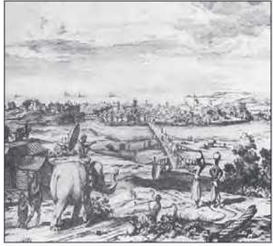
- Why are people demonstrating?
- Write a short note on the Swadeshi Movement.
Answer.
- This picture shows thousands of people demonstrating against the British Government in the Swadeshi Movement
- The Partition of Bengal was announced in 1905. This enraged many Indians against the British rulers. The Swadeshi Movement was started to discourage Indians from using foreign-made goods and use local products.
The movement grew rapidly and helped in the rise of national consciousness in India.

